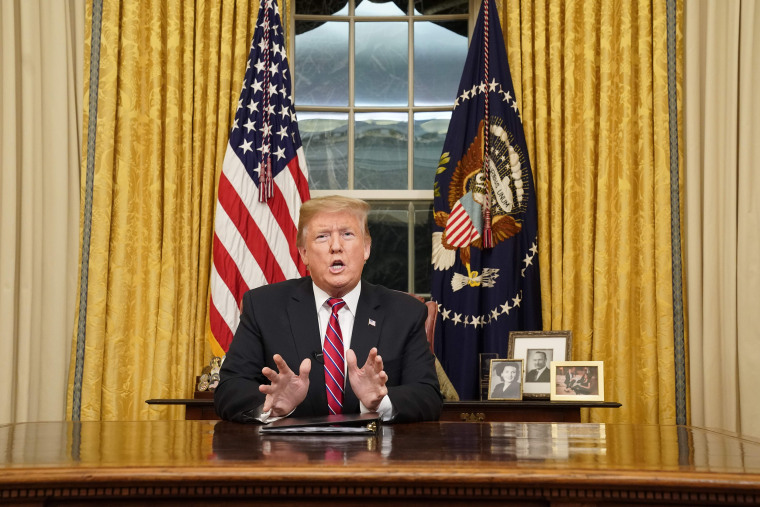Almost exactly halfway through his term, President Donald Trump finally dusted off that quintessential tool in the “bully pulpit” kit: The Oval Office address.
But if Trump and his team were pinning their hopes on Tuesday night’s speech spurring a public opinion groundswell that crests into a wall on the southern border (and his team, at least, reportedly is), they will be sorely mistaken. Few if any presidential speeches have ever turned the tide of events, and there was no reason to believe that this cooled-down pastiche of Trumpian rhetorical left-overs would be an exception.
It’s not surprising that Trump hasn’t utilized the Oval Office setting to this point: He seems happiest in a rally setting, feeding off the crowd’s Trump-exaltation. So too is he clearly more comfortable riffing rather than submitting to the tyranny of the Teleprompter. And the setting itself runs afoul of Trump’s usual rhetorical style: He tends to focus laser-like on stimulating his core supporters’ pleasure centers. The Oval Office, on the other hand, bespeaks a broader audience — an address to the nation, not just to MAGA-land.
To be fair, Trump does deserve some credit: The Oval Office is perhaps the most iconic setting for a presidential speech and by husbanding that resources he potentially maximized the value of his first prime time appearance there. This was potentially a genuine event, even from a president who cannot shut up.
Unfortunately, watching the actual address one got the impression that, without anything new to say, Team Trump hoped that the setting would imbue the speech with some sort of magic, swaying voters (or at least skittish Republican lawmakers) through sheer majesty and gravitas.
Jared Kushner, Trump’s senior adviser and son-in-law, seemingly had this notion in mind when he called members of Congress ahead of the speech. “Kushner’s message: Public support will grow for border wall after Trump’s speech and his visit to the border,” CNN’s Manu Raju reported Tuesday afternoon. “The hope is to rally GOP support and pick up a Dem defector.”
That may be how it works in the movies like “The American President” but, in real life, individual presidential addresses have rarely if ever wrought sea changes in public opinion.
That is not to say that an Oval Office speech, given all its historical forefathers, is without value. The president’s ability to educate the nation and frame a debate remains strong and important even in this fractured communications environment. But the bully pulpit is not the silver bullet imagined by either Hollywood, the public or by callow presidential advisers.
The fact that presidents have in recent decades been polarizing figures — and here is the rare category where Trump really is primus inter pares in the POTUS club — only makes it harder for a speech to sway voters. A strong presidential statement on a controversial issue is as likely to gin up as much opposition as support.
Even Trump himself understands that he’s not going to be able to talk the public into supporting his wall: “In an off-the-record lunch with television anchors hours before the address, he made clear in blunt terms that he was not inclined to give the speech or go to Texas, but was talked into it by advisers. “‘It’s not going to change a damn thing, but I’m still doing it,’ Mr. Trump said of the trip to the border,” according to The New York Times. For once, Trump is right.
And he compounded his own rhetorical impotence by giving a speech that largely recycled the same arguments that are already unpopular with the voting public. So he trotted out the same deceptions (no, 90 percent of the nation’s heroin doesn’t come through the unmonitored parts of the border), contradictions (the Democrats oppose the wall but want it to be made of steel!) and litany of gruesome crimes committed by unauthorized immigrants (fun fact: crime rates are lower among undocumented immigrants than among citizens born in this country).
The main changes were the setting, his low-energy mien (It’s not going to change a damned thing but they’re making me do it), his I’m-being-very-serious-now squint and the occasional attempts at rhetorical flourish (“This is a choice between right and wrong, justice and injustice,” he said, apparently unaware that he’s on the wrong side of that equation).
Trump wanted to stiffen the spines of members of increasingly antsy Congress who are starting to drift away from him over the government shutdown. But it will only serve to remind them that his hardline immigration focus repelled voters in droves in November.
Trump, in short, said little new and without much energy. The best reaction to the address probably came from commentator David Rothkopf: “The president’s speech made Charlie Brown’s teacher sound like Cicero,” he tweeted.
Whether Trump speaks from the Oval Office or flies down to Texas for a photo-op, he seems unable to escape the government shutdown he created. That’s unfortunate because the rest of us are trapped with him.



